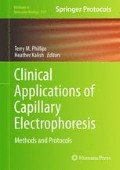Abstract
Quantitative defects in hemoglobin (Hb) are represented by Hb variants, where the amino acids sequence is modified as a consequence of a mutation in the α or β-globin genes. More than 1,100 variants have been described so far but only a few dozen are clinically significant; the most significant being Hb S, which in the homozygous state causes sickle cell disease. The majority of the methods used to detect Hb variants are based on the charge difference of the mutated globin chain. We have developed a micellar capillary electrophoresis (MEKC) method using highly acidic conditions and a high Triton® concentration. Separation times in the order of 20 min were able to resolve all normal and 29 abnormal globin chains including Hb E. This method was initially developed for Beckman P/ACE 5500 Instrument but has been modified for the more recent P/ACE MDQ and PA 800 instruments; however, the method can be adapted to any kind of CE analyzer.
Access this chapter
Tax calculation will be finalised at checkout
Purchases are for personal use only
References
Weatherall DJ (1998) Pathophysiology of thalassaemia. Baillieres Clin Haematol 11:127–146
Steinberg MH (1998) Pathophysiology of sickle cell disease. Baillieres Clin Haematol 11:163–184
Clarke GM, Higgins TN (2000) Laboratory investigation of hemoglobinopathies and thalassemias: review and update. Clin Chem 46:1284–1290
Winter WP, Yodh J (1983) Interaction of human hemoglobin and its variants with agar. Science 221:175–178
Siguret V, Andreux JP (1997) Diagnostic biologique des hémoglobinopathies par analyse du phénotype. Ann Biol Clin (Paris) 55:103–112
Wajcman H et al (2001) Abnormal hemoglobins: laboratory methods. Hemoglobin 25:169–181
Old JM (2003) Screening and genetic diagnosis of haemoglobin disorders. Blood Rev 17:43–53
Chen FT et al (1991) Capillary electrophoresis—a new clinical tool. Clin Chem 37:14–19
Ishioka N et al (1992) Detection of abnormal haemoglobin by capillary electrophoresis and structural identification. Biomed Chromatogr 6:224–226
Sahin A, Laleli YR, Ortancil R (1995) Hemoglobin analysis by capillary zone electrophoresis. J Chromatogr A 709:121–125
Jenkins MA, Hendy J, Smith IL (1997) Evaluation of hemoglobin A2 quantitation assay and hemoglobin variant screening by capillary electrophoresis. J Capillary Electrophor 4:137–143
Lin C et al (1999) Capillary zone electrophoresis: an additional technique for the identification of hemoglobin variants. Hemoglobin 23:97–109
Gulbis B et al (2003) The place of capillary electrophoresis techniques in screening for haemoglobinopathies. Ann Clin Biochem 40:659–662
Cotton F et al (2009) Evaluation of an automated capillary electrophoresis system in the screening for hemoglobinopathies. Clin Lab 55:217–221
Mantikou E, Harteveld CL, Giordano PC (2010) Newborn screening for hemoglobinopathies using capillary electrophoresis technology: testing the Capillarys Neonat Fast Hb device. Clin Biochem 43:1345–1350
Zhu M et al (1992) Capillary electrophoresis of hemoglobins and globin chains. J Chromatogr 608:225–237
Zhu M et al (1993) Capillary electrophoresis of abnormal hemoglobins associated with alpha-thalassemias. J Chromatogr 652:119–129
Molteni S, Frischnecht H, Thormann W (1994) Application of dynamic capillary isoelectric focusing to analysis of human hemoglobin variants. Electrophoresis 15:22–30
Hempe JM, Craver RD (1994) Quantification of hemoglobin variants by capillary isoelectric focusing. Clin Chem 40:2288–2295
Hempe JM et al (1997) Analysis of haemoglobin variants by capillary isoelectric focusing. J Capillary Electrophor 4:131–135
Hempe JM, Granger JN, Craver RD (1997) Capillary isoelectric focusing of hemoglobin variants in the pediatric clinical laboratory. Electrophoresis 18:1785–1795
Mario N et al (1997) Capillary isoelectric focusing and high-performance cation-exchange chromatography compared for qualitative and quantitative analysis of hemoglobin variants. Clin Chem 43:2137–2142
Mario N, Baudin B, Giboudeau J (1998) Qualitative and quantitative analysis of hemoglobin variants by capillary isoelectric focusing. J Chromatogr B 706:123–129
Jenkins MA, Ratnaike S (1999) Capillary isoelectric focusing of haemoglobin variants in the clinical laboratory. Clin Chim Acta 289:121–132
Hempe JM, Craver RD (2000) Separation of hemoglobin variants with similar charge by capillary isoelectric focusing: value of isoelectric point for identification of common and uncommon hemoglobin variants. Electrophoresis 21:743–748
Conti M, Gelfi C, Righetti PG (1995) Screening of umbilical cord blood hemoglobins by isoelectric focusing in capillaries. Electrophoresis 16:1485–1491
Craver RD et al (1997) Hemoglobin A2 levels in healthy persons, sickle cell disease, sickle cell trait, and beta-thalassemia by capillary isoelectric focusing. Am J Clin Pathol 107:88–91
Shihabi ZK, Hinsdale ME, Daugherty HK (2000) Hemoglobin A2 quantification by capillary zone electrophoresis. Electrophoresis 21:749–752
Doelman CJ et al (1997) Capillary electrophoresis system for hemoglobin A1c determinations evaluated. Clin Chem 43:644–648
Cotton F et al (1999) Evaluation of a capillary electrophoresis method for routine determination of hemoglobins A2 and F. Clin Chem 45:237–243
Cotton F et al (1999) Interference of haemoglobin D in hemoglobin A2 measurement by cation-exchange HPLC. Clin Chem 45:1317–1318
Louahabi A et al (2006) Evaluation of a new Sebia kit for analysis of hemoglobin fractions and variants on the Capillarys system. Clin Chem Lab Med 44:340–345
Yang Z et al (2009) Prevalence of elevated hemoglobin A2 measured by the CAPILLARYS system. Am J Clin Pathol 131:42–48
Higgins T, Mack M, Khajuria A (2009) Comparison of two methods for the quantification and identification of hemoglobin variants. Clin Biochem 42:701–705
Leone L et al (1985) Reversed-phase high-performance liquid chromatography of human haemoglobin chains. J Chromatogr 321:407–419
Ong CN, Liau LS, Ong HY (1992) Separation of globins using free zone capillary electrophoresis. J Chromatogr 576:346–350
Shihabi ZK, Hinsdale ME (2005) Simplified hemoglobin chain detection by capillary electrophoresis. Electrophoresis 26:581–585
Lin C et al (1998) Separation of human globin chains by micellar electrokinetic capillary chromatography. J Chromatogr B 719:47–54
Author information
Authors and Affiliations
Corresponding author
Editor information
Editors and Affiliations
Rights and permissions
Copyright information
© 2013 Springer Science+Business Media, LLC
About this protocol
Cite this protocol
Cotton, F., Gulbis, B. (2013). Separation of Hemoglobin Variants by Capillary Electrophoresis. In: Phillips, T., Kalish, H. (eds) Clinical Applications of Capillary Electrophoresis. Methods in Molecular Biology, vol 919. Humana Press, Totowa, NJ. https://doi.org/10.1007/978-1-62703-029-8_12
Download citation
DOI: https://doi.org/10.1007/978-1-62703-029-8_12
Published:
Publisher Name: Humana Press, Totowa, NJ
Print ISBN: 978-1-62703-028-1
Online ISBN: 978-1-62703-029-8
eBook Packages: Springer Protocols

